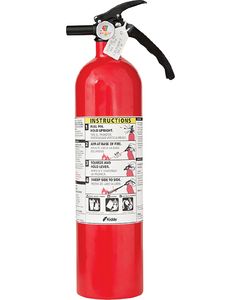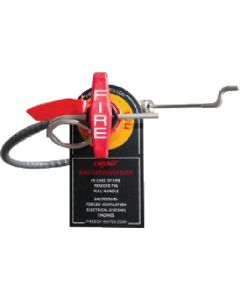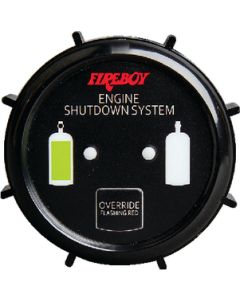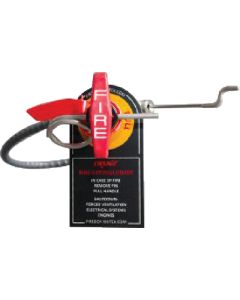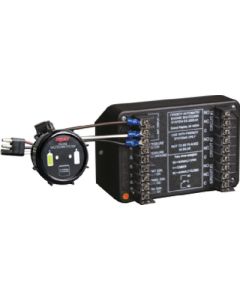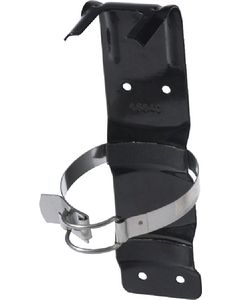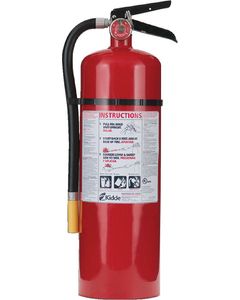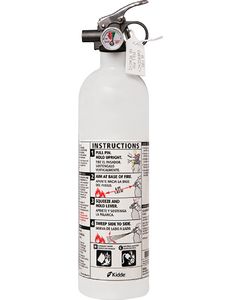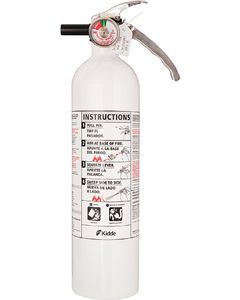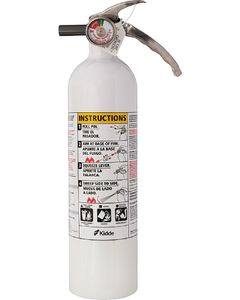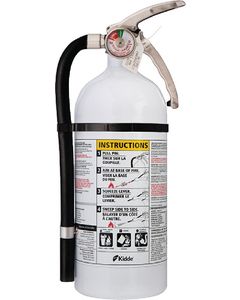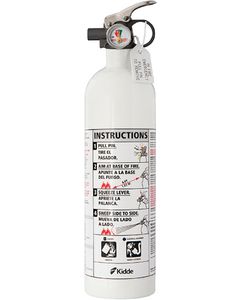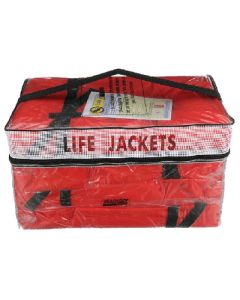Fire Alarms And Extinguishers
FIRE EXTINGUISHERS FOR BOATS
To have fire extinguishers on board is essential, because boats usually carry fuel or have an electrical system. There are many kinds of fire extinguishers but they all have to be approved by the U. S. Coast Guard.
Boats with enclosed engine compartments, cabins and living quarters are required by the U.S. Coast Guard to have approved fire extinguishers on board.
Fire extinguishers are classified by letters and numbers according to the class and size fire they can put out. The letter, (A, B, C, or D) indicates the class of fire. The number is a measure of the capacity of the extinguisher - the larger the number, the greater the capacity of extinguishing material to put out a fire.
The letter “A” indicates that it for combustible solids like wood.
The letter “B” indicates that it is for flammable liquids such as gasoline.
The letter “C” indicates that it is for electrical fires.
The letter “D” indicates that it is for combustible metals like magnesium.
Sometimes there are fires that are caused when paper and wood are burned. These fires would require “Class A” fire extinguishers, however they can be put out with water. Never use water on gasoline, oil, or electrical fires. Water causes gasoline and oil fires to spread and electrical current is conducted through water.
It is necessary to inspect the fire extinguishers on a monthly basis. Fire extinguishers need to be properly stored, charged and undamaged. It is important to mount portable fire extinguishers where they are readily accessible. Check the gauge frequently and make sure that the fire extinguishers are still charged. Inspect the seals to make sure they have not been tampered with. Always replace cracked or broken hoses and be sure to keep nozzles free from obstruction. It is important to weigh the fire extinguishers to confirm that they meet the minimum weight specified on the label. After you use a fire extinguisher, it should be recharged, if it is rechargeable. If it is a disposable fire extinguisher, then it should be replaced. Make sure that the fire extinguisher label indicates that it is a U.S. Coast Guard approved marine type device.
Make sure your fire extinguishers are always located where readily accessible. A fire onboard is a dangerous situation. Fire extinguishers are needed in a boat to put out a fire. If you can’t control the fire, the only option you have is to go in the water. Fuel, oxygen and heat must be present to start a fire. If one of them is removed, then the fire is extinguished.
You need to take precautions with gasoline and propane because these fuels can be very hazardous. The fumes of these fuels are heavier than air and tend to collect in the cabin, bilge and other lower areas of the boat. It is absolutely necessary to keep these areas clean and free of trash because they naturally are surrounded by oxygen and all that is necessary to start a fire is heat. This could come from something as simple as a spark from an ignition component.
All boats that use gasoline for electrical generation, mechanical power or propulsion are required to be equipped with a ventilation system. The ventilation system may be either natural or powered. The ventilation system removes fuel vapors from the bilge by circulating air through the engine and fuel tank compartments.
The owner of the boat is responsible for keeping the boat’s ventilation systems in operating condition. Make sure that the openings are free of obstructions, that the ducts are not blocked or torn, that the blowers are operating properly and that worn out parts are replaced with equivalent marine type equipment.
It is essential that you read and understand the instructions on the fire extinguishers that are on board. If there is a fire you must be prepared and not hesitate. Grab the fire extinguisher, activate it, and direct it at the base of the flames using short bursts and sweeping it from side to side.
If underway and a fire starts, stop the boat and position it in such a manner that the fire is downwind. Order everyone to put on lifejackets. If possible, try to turn off the fuel source to the fire. Grab the fire extinguishers and control the fire.
To have fire extinguishers on board is essential, because boats usually carry fuel or have an electrical system. There are many kinds of fire extinguishers but they all have to be approved by the U. S. Coast Guard.
Boats with enclosed engine compartments, cabins and living quarters are required by the U.S. Coast Guard to have approved fire extinguishers on board.
Fire extinguishers are classified by letters and numbers according to the class and size fire they can put out. The letter, (A, B, C, or D) indicates the class of fire. The number is a measure of the capacity of the extinguisher - the larger the number, the greater the capacity of extinguishing material to put out a fire.
The letter “A” indicates that it for combustible solids like wood.
The letter “B” indicates that it is for flammable liquids such as gasoline.
The letter “C” indicates that it is for electrical fires.
The letter “D” indicates that it is for combustible metals like magnesium.
Sometimes there are fires that are caused when paper and wood are burned. These fires would require “Class A” fire extinguishers, however they can be put out with water. Never use water on gasoline, oil, or electrical fires. Water causes gasoline and oil fires to spread and electrical current is conducted through water.
It is necessary to inspect the fire extinguishers on a monthly basis. Fire extinguishers need to be properly stored, charged and undamaged. It is important to mount portable fire extinguishers where they are readily accessible. Check the gauge frequently and make sure that the fire extinguishers are still charged. Inspect the seals to make sure they have not been tampered with. Always replace cracked or broken hoses and be sure to keep nozzles free from obstruction. It is important to weigh the fire extinguishers to confirm that they meet the minimum weight specified on the label. After you use a fire extinguisher, it should be recharged, if it is rechargeable. If it is a disposable fire extinguisher, then it should be replaced. Make sure that the fire extinguisher label indicates that it is a U.S. Coast Guard approved marine type device.
Make sure your fire extinguishers are always located where readily accessible. A fire onboard is a dangerous situation. Fire extinguishers are needed in a boat to put out a fire. If you can’t control the fire, the only option you have is to go in the water. Fuel, oxygen and heat must be present to start a fire. If one of them is removed, then the fire is extinguished.
You need to take precautions with gasoline and propane because these fuels can be very hazardous. The fumes of these fuels are heavier than air and tend to collect in the cabin, bilge and other lower areas of the boat. It is absolutely necessary to keep these areas clean and free of trash because they naturally are surrounded by oxygen and all that is necessary to start a fire is heat. This could come from something as simple as a spark from an ignition component.
All boats that use gasoline for electrical generation, mechanical power or propulsion are required to be equipped with a ventilation system. The ventilation system may be either natural or powered. The ventilation system removes fuel vapors from the bilge by circulating air through the engine and fuel tank compartments.
The owner of the boat is responsible for keeping the boat’s ventilation systems in operating condition. Make sure that the openings are free of obstructions, that the ducts are not blocked or torn, that the blowers are operating properly and that worn out parts are replaced with equivalent marine type equipment.
It is essential that you read and understand the instructions on the fire extinguishers that are on board. If there is a fire you must be prepared and not hesitate. Grab the fire extinguisher, activate it, and direct it at the base of the flames using short bursts and sweeping it from side to side.
If underway and a fire starts, stop the boat and position it in such a manner that the fire is downwind. Order everyone to put on lifejackets. If possible, try to turn off the fuel source to the fire. Grab the fire extinguishers and control the fire.

